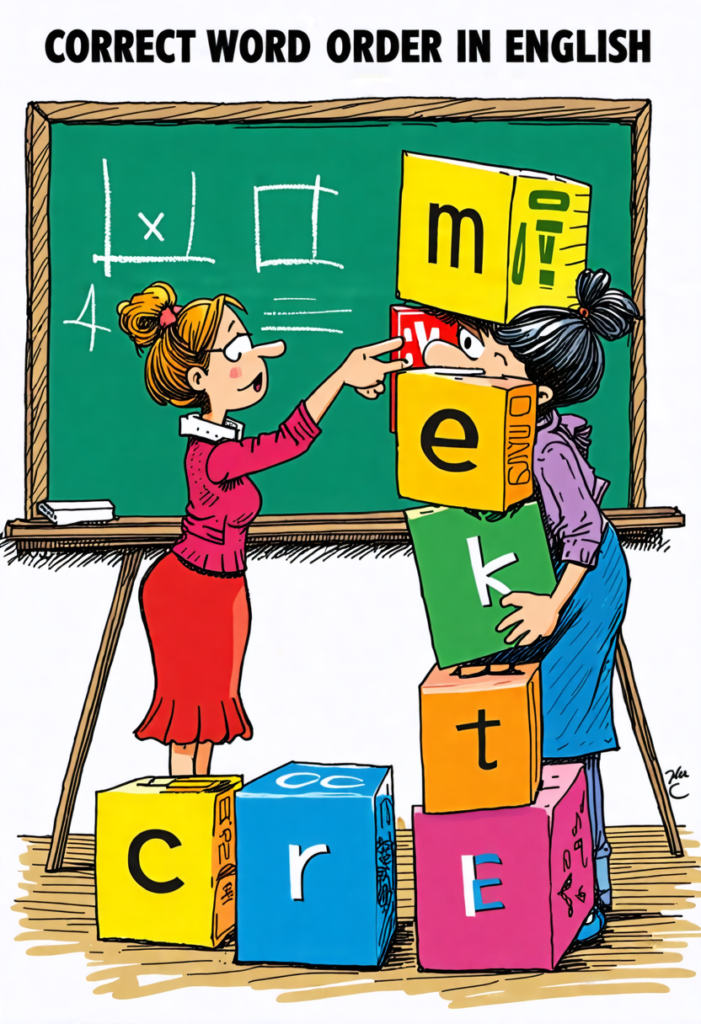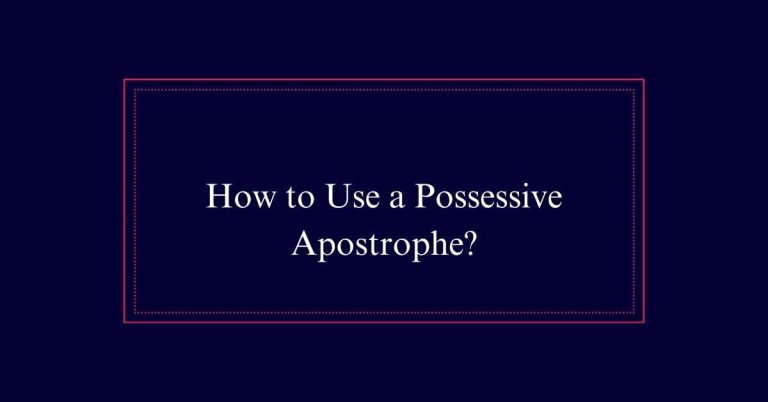What is the correct word order in English?
In English, the correct word order is generally subject-verb-object. For example, ‘She reads a book’ – here, ‘She’ is the subject, ‘reads’ is the verb, and ‘a book’ is the object. This structure helps maintain clarity in communication. Adhering to subject-verb agreement is important, as mismatches can cause confusion, like ‘She walks’ versus ‘They walk.’ When forming questions, invert the subject and verb, such as ‘Does she read?’
Fixed Word Order in English
In English, sentences typically follow a fixed order of subject, verb, and object. This structure guarantees clarity and coherence in communication.
For example, in the sentence ‘She reads a book,’ ‘She’ is the subject, ‘reads’ is the verb, and ‘a book’ is the object. This pattern is essential for understanding and constructing sentences accurately. Deviating from this order can lead to confusion.
In questions, the subject and verb often invert, such as ‘Is she reading a book?’ This inversion signals to the reader or listener that a question is being asked.
Subject-Verb Agreement
Ensuring subject-verb agreement is essential for clear and grammatically correct sentences. This rule means that the verb must match the subject in number and person.
For example, in the sentence ‘She walks to work,’ ‘she’ is a singular subject and ‘walks’ is the singular form of the verb. In contrast, ‘They walk to work’ pairs the plural subject ‘they’ with the plural verb ‘walk.’
Mistakes in subject-verb agreement can confuse readers and obscure the intended meaning. Regular practice and attention to detail can help in mastering this aspect of grammar. Using tools and resources like grammar checkers can also assist in identifying and correcting errors in subject-verb agreement.
Forming Questions Correctly
Forming questions correctly in English requires understanding the inversion of the subject and verb. This means that in questions, the verb precedes the subject. For example, ‘She is a friend’ becomes ‘Is she a friend?’ Mastering this structure is essential for clear communication.
Key points to remember include:
- Auxiliary verbs: Use auxiliary verbs (is, are, do, does) to form questions. ‘Does she like apples?’
- Wh- questions: Start with question words (who, what, where) followed by the verb. ‘What is your name?’
- Verb tenses: Make sure the verb tense matches the context. ‘Will you attend the meeting?’
Importance of Clarity
Mastering question formation is just one aspect of achieving clarity in communication. Clear word order in sentences guarantees that the intended message is easily understood by the reader or listener. Misplacing words can lead to confusion and misinterpretation.
For example, ‘Eats shoots and leaves’ differs greatly from ‘Eats, shoots, and leaves.’ Precise grammar and correct word order guide the reader through the sentence, creating coherence and flow. This is especially important in professional and academic settings where misunderstandings can have significant consequences.

Clarity in writing not only reflects well on the writer but also fosters effective communication. Therefore, adhering to correct word order is essential for conveying ideas accurately and efficiently.
Grammar Rules and Structure
A solid understanding of grammar rules and sentence structure is fundamental for clear and effective communication. English typically follows a subject-verb-object order. Mastering this structure aids in writing coherent sentences. Proper grammar guarantees that your message is easily understood.
Consider these key points:
- Consistency: Uniform application of grammar rules maintains clarity.
- Verb Placement: Correct verb positioning is essential for readability.
- Modifiers: Properly placed modifiers avoid ambiguity.
Types of English Sentences
English sentences come in various types, each serving a unique purpose in communication. Declarative sentences make statements or express opinions, such as ‘She loves music.’
Interrogative sentences pose questions, for example, ‘Do you like coffee?’
Imperative sentences give commands or make requests, like ‘Please close the door.’
Exclamatory sentences convey strong emotions, such as ‘What a beautiful day!’
Each type of sentence adds variety and depth to writing. Understanding these different types helps in constructing clear and effective communication.
Using a mix of these sentences can enhance the readability and engagement of your writing. Mastering the use of sentence types is fundamental for anyone aiming to improve their English language skills.
Role of Verbs
Verbs consistently serve as the backbone of sentence construction. They indicate actions, states, or occurrences, forming the crux of any sentence.
In English, the typical word order is subject-verb-object. This structure guarantees clarity and coherence. For example, in the sentence ‘She writes a letter,’ ‘writes’ is the verb that connects the subject ‘She’ with the object ‘a letter.’
Verbs also play a pivotal role in forming questions and negations. In questions, the verb often precedes the subject, as in ‘Does she write?’ Negations are formed by adding ‘not’ after auxiliary verbs, e.g., ‘She does not write.’
Mastering the role of verbs is essential for constructing clear and effective sentences in English.
Parts of Speech
Understanding the role of verbs is just one aspect of mastering the various parts of speech in English. Parts of speech are the building blocks of sentences. They include nouns, verbs, adjectives, adverbs, pronouns, prepositions, conjunctions, and interjections.
Each part of speech serves a unique function:
- Nouns: Represent people, places, things, or ideas.
- Adjectives: Describe or modify nouns.
- Conjunctions: Link words, phrases, or clauses.
Knowing how to use each part of speech correctly is crucial for proper sentence construction. It guarantees that sentences are clear and coherent. For instance, adjectives enhance nouns by providing more detail, while conjunctions enable the formation of complex sentences.
Mastering these elements improves both written and spoken communication.
Punctuation and Spelling
Correct punctuation and spelling are essential to clear and effective written communication. Proper punctuation aids in conveying the intended meaning, while correct spelling guarantees comprehension. Misplaced commas or misspelled words can alter the message, leading to misunderstandings.
| Punctuation Mark | Usage Example |
|---|---|
| Comma | Separates items in a list |
| Period | Ends a declarative sentence |
| Question Mark | Ends an interrogative sentence |
| Exclamation Mark | Conveys strong emotion |
| Apostrophe | Indicates possession or contraction |
Adhering to punctuation rules and spelling guidelines enhances writing professionalism. It is crucial for business emails, academic papers, and everyday communication. Regular practice and use of tools like spell checkers can improve these skills. Always proofread your work to guarantee accuracy.
Frequently Asked Questions
How Do Idioms Affect Sentence Structure in English?
Idioms affect sentence structure by introducing fixed expressions that may not follow standard grammar rules. They often convey meanings beyond the literal words, adding richness and nuance to language, but may challenge non-native speakers.
What Are Some Common English Sentence Patterns?
Common English sentence patterns include subject-verb-object (SVO), subject-verb-complement (SVC), and subject-verb-indirect object-direct object (SVIODO). These patterns provide clear and structured communication, essential for effective writing and speaking.
How Can Passive Voice Impact Sentence Clarity?
Passive voice can reduce sentence clarity by obscuring the subject performing the action. It often leads to longer, more complex sentences. Active voice is usually clearer and more direct, improving readability and comprehension.
What Role Do Conjunctions Play in Complex Sentences?
Conjunctions connect clauses in complex sentences, allowing for more detailed and nuanced expression. They help in showing relationships between ideas, such as cause and effect or contrast, thereby enhancing the coherence and flow of writing.
How Do Modifiers Change the Meaning of a Sentence?
Modifiers change the meaning of a sentence by providing additional information about a noun, verb, or phrase. They can clarify, specify, or enhance details, thereby altering the overall context and improving the reader’s understanding.







